AMD Carrizo Part 2: A Generational Deep Dive into the Athlon X4 845 at $70
by Ian Cutress on July 14, 2016 9:00 AM ESTAnalyzing Generational Updates
Going through the benchmark data for our Carrizo part compared to Kaveri, Richland and Trinity gives two very different sides of the same story. Simply put, it would come across that Carrizo is overall better at CPU tasks when you compare clock for clock, but performs worse when a discrete graphics card is in play for gaming. There are some slight exceptions for both sides of this story, especially when larger memory accesses comes in, but this comes down to the design choices when Carrizo for desktop was made. The fact that we have a laptop CPU in desktop clothing is going to be a main detractor when it comes to gaming, but the CPU compute side of the equation is very promising indeed.
In our generational testing, we compared the following four processors at 3 GHz and running the highest supported JEDEC memory speeds for each:
| AMD CPUs | ||||||||||||
| µArch / Core |
Cores | Base Turbo |
TDP | DDR3 | L1 (I) Cache |
L1 (D) Cache |
L2 Cache |
|||||
| Athlon X4 845 |
Excavator Carrizo |
4 | 3500 3800 |
65 W | 2133 | 192KB 3-way |
128KB 8-way |
2 MB 16-way |
||||
| Athlon X4 860K |
Steamroller Kaveri |
4 | 3700 4000 |
95 W | 1866 | 192KB 3-way |
64KB 4-way |
4 MB 16-way |
||||
| Athlon X4 760K |
Piledriver.v2 Richland |
4 | 3800 4100 |
100 W | 1866 | 128KB 2-way |
64KB 4-way |
4 MB 16-way |
||||
| Athlon X4 750K |
Piledriver Trinity |
4 | 3400 4000 |
100 W | 1866 | 128KB 2-way |
64KB 4-way |
4 MB 16-way |
||||
It is worth noting that for the most part the X4 750K and X4 760K are essentially equal, using a slightly modified Piledriver v2 microarchitecture for the X4 760K that in most cases performs similarly to the other processor at the same frequency. This will come through in almost all of our benchmark comparisons. However, the main battle will be between the top two.
Comparing the Upgrade: 2012 to 2016
Our results are going to be compared in two different ways. Firstly, we are going to look at the absolute improvement of each processor compared to the lowest one in the test: Trinity. This gives a direct analysis of the performance increase per clock total increase for every generation from 2012 to 2016. What follows is a series of graphs for each of our benchmark sections showing the results of each benchmark as a percentage improvement over Trinity. We'll analyze each one in turn.
From our Real World benchmarks, Carrizo gets a good showing in three of the benchmarks, showing a sizeable jump over Kaveri, however WinRAR and WebXPRT are a little lower.
For the office tests, Carrizo takes the biggest gain for CineBench and Handbrake, but sits behind in Photoscan and Hybrid. HandBrake shows a sizable gain in both tests compared to Trinity.
The Linux-Bench tests shows Carrizo behind Kaveri in each instance, and behind Richland for all three Redis tests. As we explained in that section, Redis is very memory dependent and as a result, despite having the larger L1 cache, only having 2 MB of L2 cache is a blow to the Carrizo part.
So here is where it is interesting. If you were only looking at synthetic and legacy tests in isolation, like many other review websites do, then you could be forgiven that it shows Carrizo taking a distinct lead in every benchmark (except 7-zip). In many cases there is a 10-20% gain over Kaveri.
For gaming, as explained in the testing, despite the improvement over Trinity that Carrizo offers, the deficit to Kaveri is consistent across the board.
Comparing IPC
Next, we have the generational updates moving from Trinity to Richland to Kaveri to Carrizo. This is where we typically expect to see single-digit percentage increases moving through the generations, with double digits for large gains or introduction of new IP blocks into the silicon (e.g. encryption or video conversion). Again, we go through each of our five benchmark sections for this.
3DPM v2 takes the biggest gain, a massive 32% over Kaveri, due to better memory management and a larger L1 cache. WinRAR, being memory dependent, loses due to the smaller L2.
The office tests are a mixed bag - we see a regression in Photoscan due to large memory accesses, but it is clear that Kaveri was a bigger jump for a number of things than Carrizo.
Our Linux tests get a poor showing across the board from Carrizo, which we saw in the results. In each case, the IPC for Carrizo is lower than that of Kaveri.
Back with the previous legacy results graph, we saw that Carrizo had a better performance than Kaveri across the board, except 7-zip. Translating this to IPC improvements and we see that in half the cases, moving to Kaveri was better than moving to Carrizo, with CineBench single threaded tests being the exception showing the capability of the core logic in Carrizo.
However, the big result will be for gaming. Clock for Clock, Carrizo gives an average 5.8% decrease in performance to Kaveri.
Conclusions
Wrapping all the numbers together, we get the following average IPC improvements for a Carrizo with 2MB of L2 cache over Kaveri with 4MB of L2 cache for each section:
| AMD Average IPC Increases | |||||||
| Benchmark Suite | Richland over Trinity | Kaveri over Richland | Carrizo over Kaveri | ||||
| Real World | 0.8% | 8.0% | 8.8% | ||||
| Office | -0.1% | 11.1% | 4.1% | ||||
| Legacy | 0.1% | 11.8% | 8.5% | ||||
| Overall Windows |
0.3% | 10.3% | 7.3% | ||||
| Linux | 10.4% | 10.5% | -12.1% | ||||
| Gaming | -0.4% | 12.5% | -5.8% | ||||
The headline figure, for CPU compute benchmarks (real world, office and legacy), is that Carrizo offers a +7.3% improvement over AMD's previous microarchitecture, Kaveri. It comes with the caveat that Linux and Gaming performance, which in our tests tend to rely more on memory accesses, perform 6-12% worse.


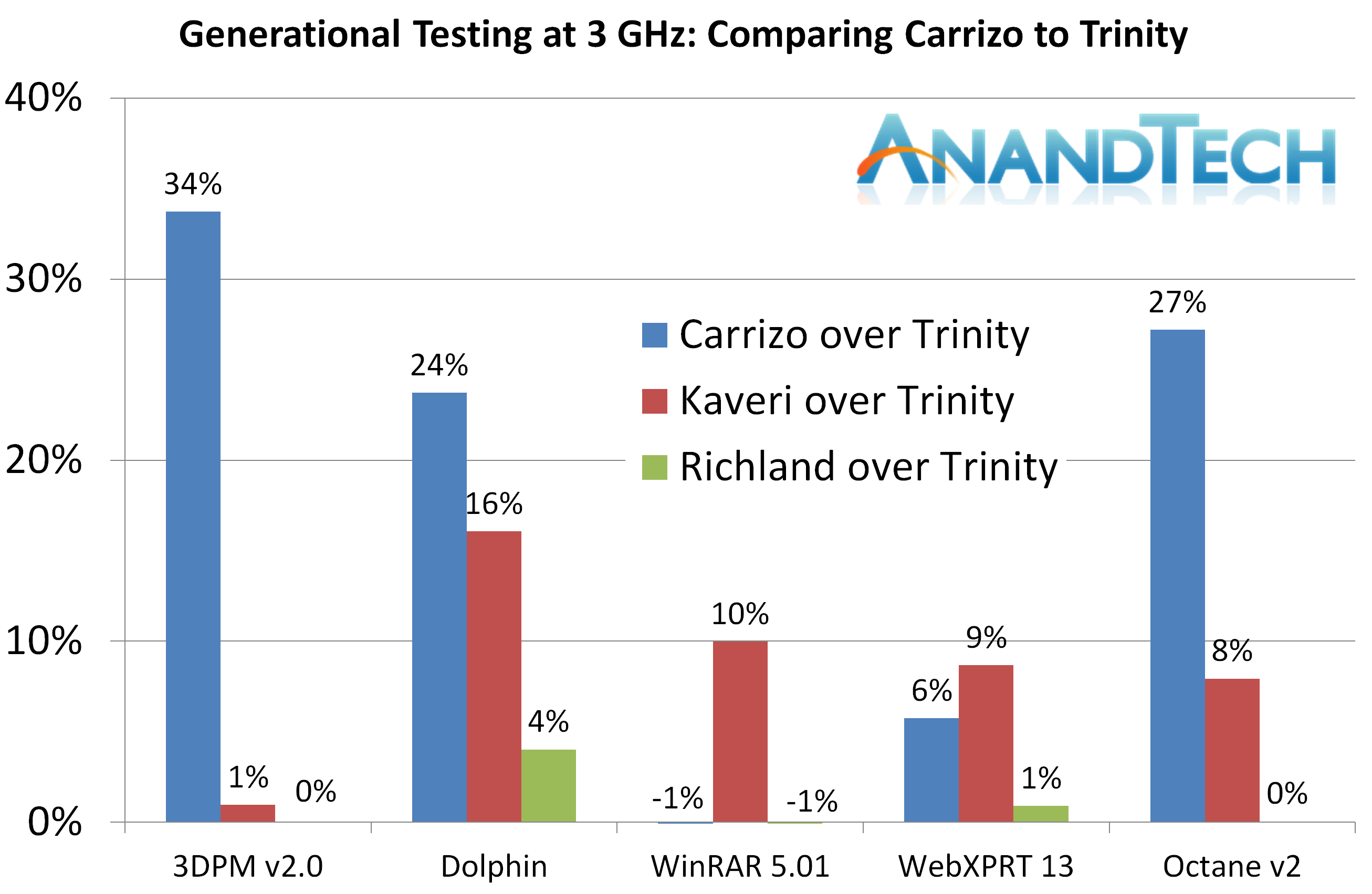
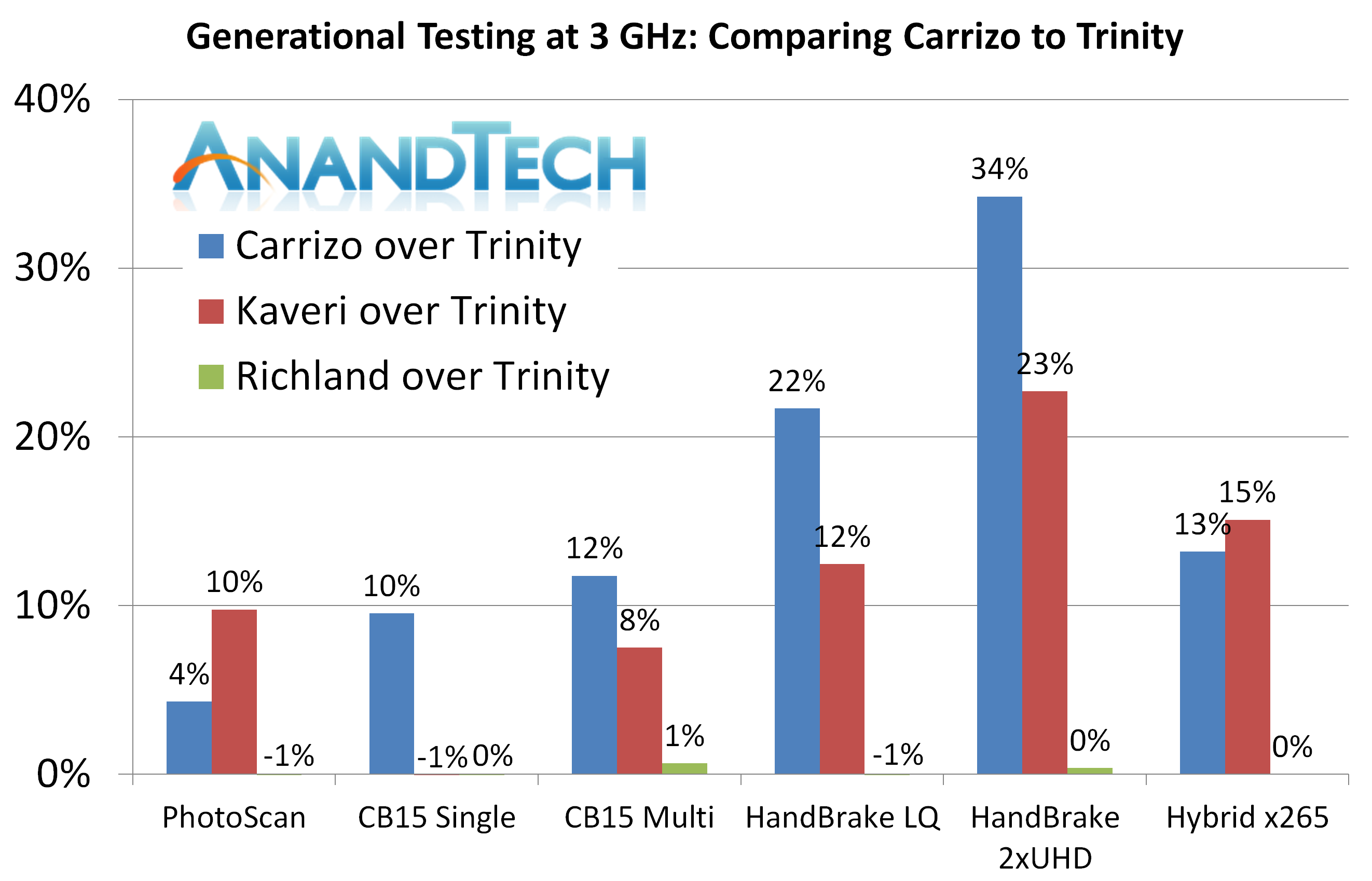
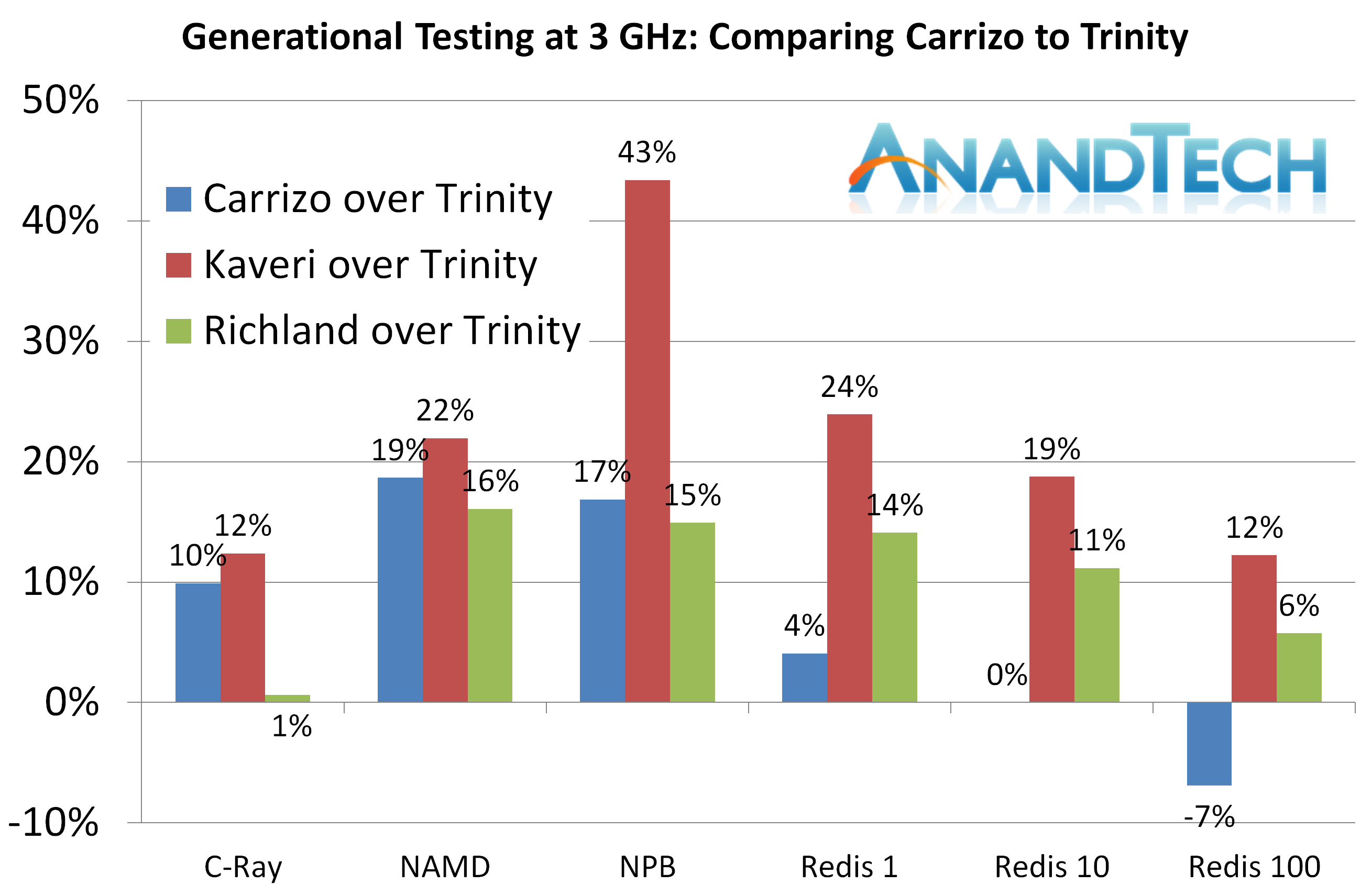
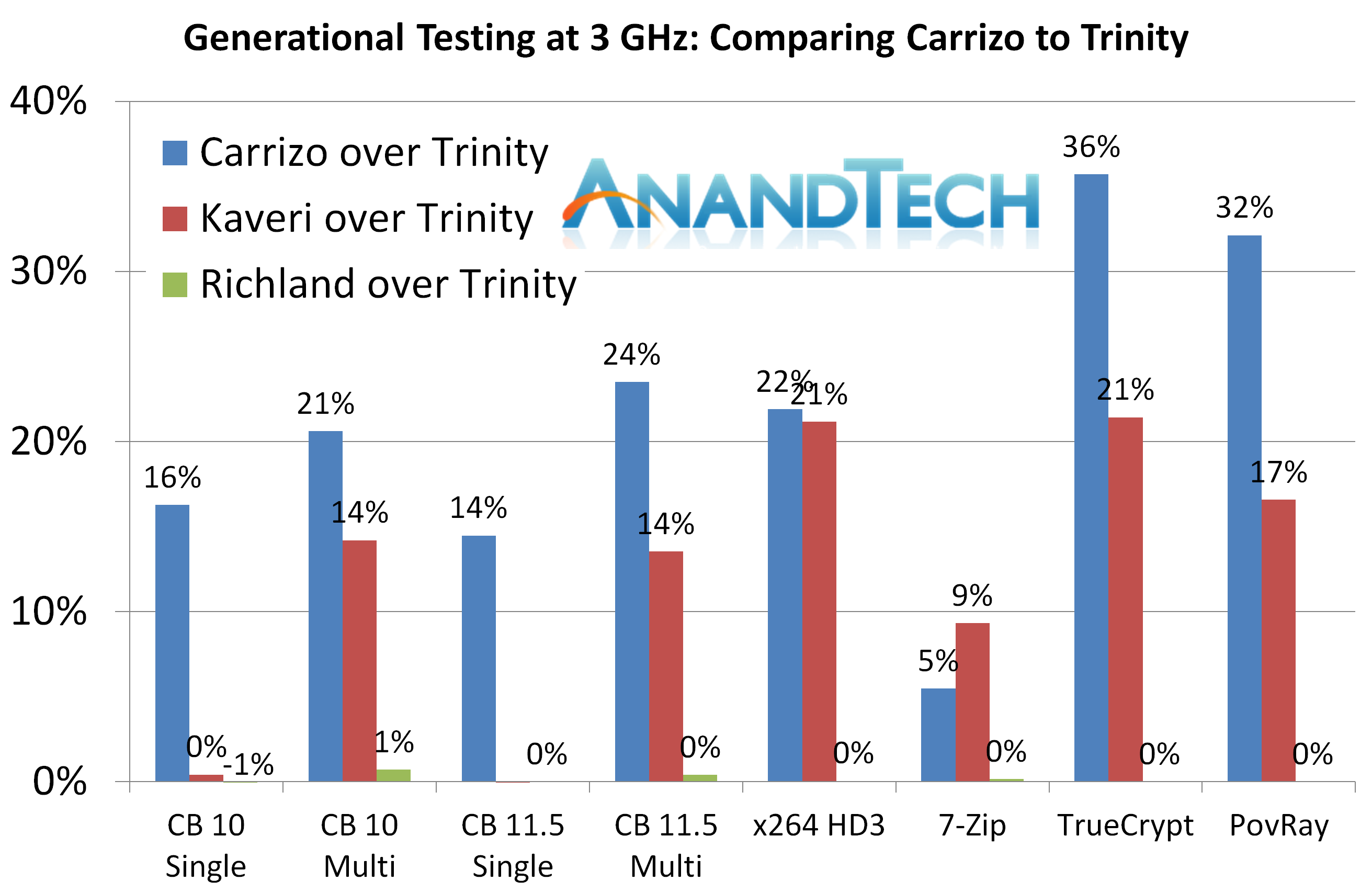

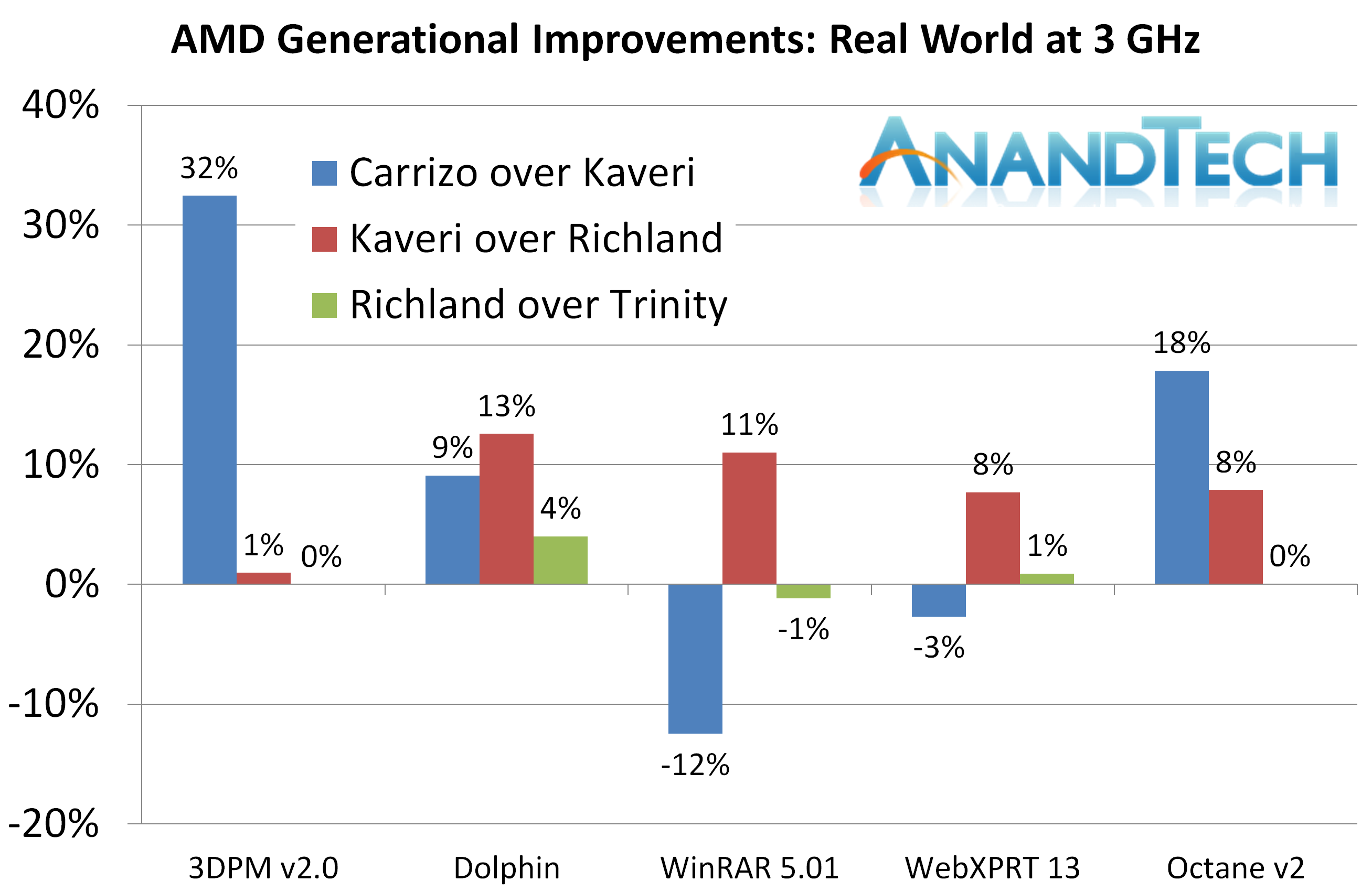


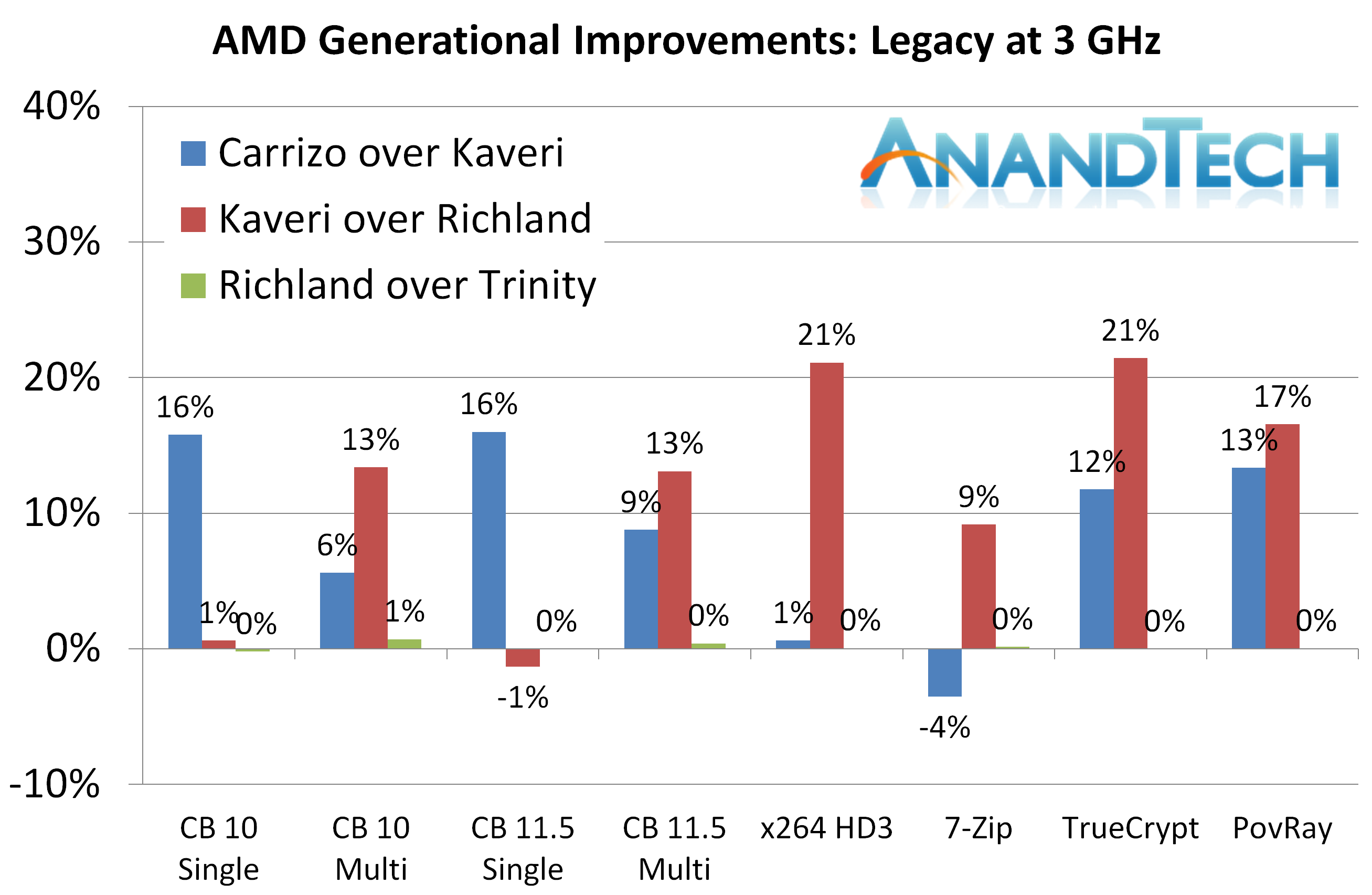
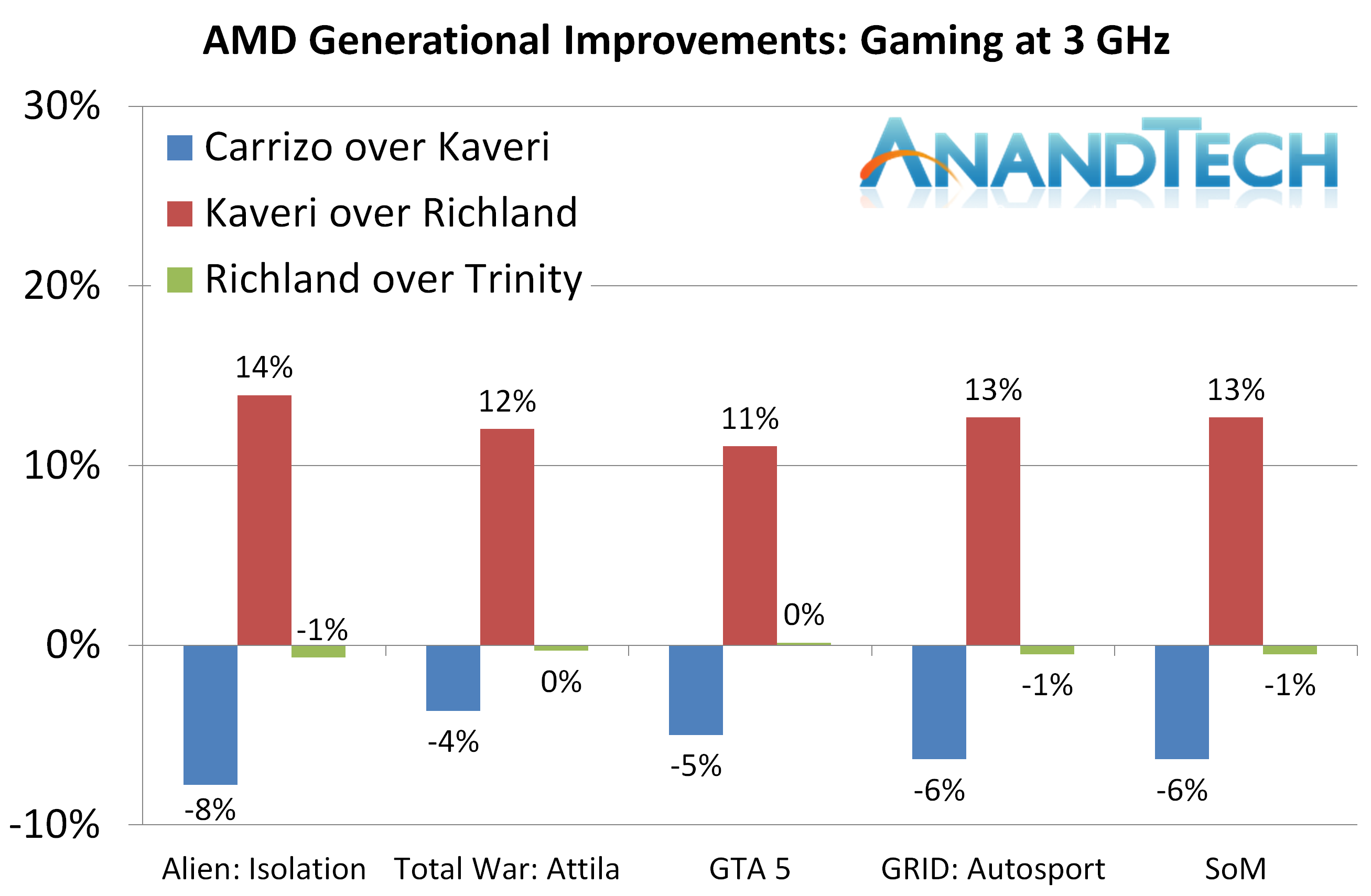








131 Comments
View All Comments
aryonoco - Friday, July 15, 2016 - link
Oh great, another AMD Bulldozer CPU, on 28nm, in 2016.I can't even begin to pretend to be enthusiastic about this.
The only people who will buy this are internet cafe/game centres in developing countries; none of whom care about AT says. I wonder why Ian thought he should spend so much time thoroughly reviewing a part that not one of AT's readers will ever buy.
Cryio - Friday, July 15, 2016 - link
To be fair this is an architecture from 2015 brought to desktops half-hearted and it wasn't released for any good reason IMO.Given the improvements Kaveri and Carizzo pose over the previous generations most of the time, if AMD would have released FX CPUs based on Stream Roller and Excavator, we would've got some interesting CPUs.
kondor999 - Friday, July 15, 2016 - link
Oh look, another shitty, hot, antiquated AMD CPU that only (gosh, I can't actually think of anyone) would buy.I really wish they'd get their act together. Not necessarily because I'd buy their products, but just to force Intel into giving us more than a 3% (or so) IPC iterative improvement.
TheinsanegamerN - Friday, July 15, 2016 - link
So, if you only want AMD to be competitive so that intel is more competitive, how do you expect them to do that when nobody buys their stuff? R and D needs money.silverblue - Friday, July 15, 2016 - link
Though temperature readings appear to be a bit hard to come by, the 845 appears to idle at 26 degrees and full load on AIDA64 at 40 degrees which puts it below anything else AMD has, making it comparable to the Pentium G3220 (though the former does have a better cooling solution).Source: http://www.eteknix.com/amd-athlon-x4-845-carrizo-p...
It's up to you whether you want to believe that or not.
Meteor2 - Saturday, July 16, 2016 - link
I don't think there's more than 3℅ IPC increase annually available. Apple, ARM, Qualcomm and Intel all seem to be converging at any given power.zodiacfml - Friday, July 15, 2016 - link
Waste of time. Yes, it competes with the Pentium, but the Intel chip has integrated graphics which could be useful whether the user has a graphics card or not. Paying more for less.Talking about Zen, it will just compete with Haswell generation chips. Intel knew this which is why their tick-tock strategy has slowed down.
cocochanel - Friday, July 15, 2016 - link
Intel didn't slow down because of AMD. It's because of x86. It's harder and harder even for mighty Intel engineers to squeeze more performance from an antiquated ISA. The fact that Zen took so long to get here it's a clear indication of the same.TheinsanegamerN - Monday, July 18, 2016 - link
There is no clear indicationAMD has far fewer resources then intel does, so it makes sense it would take them much longer to make a new CPU arch then intel.
Intel isnt making any advancements because they have no competition. There may be more performance sitting in their arch they are not using, since there really is no reason to.
Lolimaster - Saturday, July 16, 2016 - link
Carrizo totally gimped by l2 cache.The problem is that Bristol Ridge comes with the same pathetic 2MB for their 4 cores APU.